“An iPhone, arguably the greatest thing ever made, has no evidence that a human being made it.”
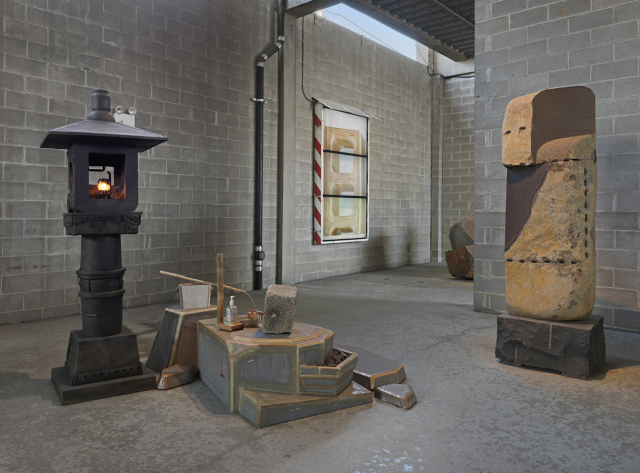
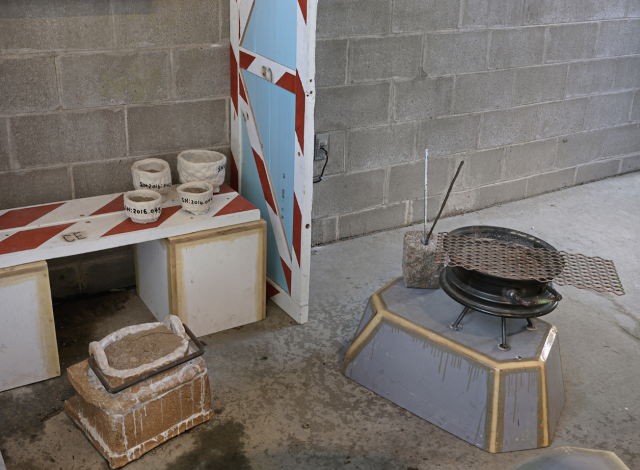
60-461/761: Experimental Capture
CMU School of Art / IDeATe, Spring 2020 • Profs. Golan Levin & Nica Ross
“An iPhone, arguably the greatest thing ever made, has no evidence that a human being made it.”


Learning to see: Gloomy Sunday from Memo Akten on Vimeo.
I didn’t want to post GAN art because it’s very predictable of me, but I thought it was interesting how the ‘Camera Transformed’ article conceived of them as capturing unseen possible aspects of reality through the latent space of an image dataset.
In Learning to see, artist Memo Akten trained a generative adversarial network (GAN), a type of machine learning model, using the Pix2Pix (pixel-to-pixel translation) technique. With Pix2Pix, the ML model learns a statistical mapping between representation A of an image and representation B. In this case, Akten used photographs of plants and landscapes as one representation, and line drawings of the same scene (generated by a simple edge detection algorithm) for another. Thus, the trained model could pick up the general edge arrangement of a mundane scene, like car keys and wires on a table, and translate it into the visual representation it was familiar with (natural scenes.)
Philosophically, the piece is interesting because it shows how preconceived notions of reality affect capture: art is never neutral. As Akten notes, the model “can only see what it already knows, just like us.” For this model, even a decidedly un-sublime environment doesn’t incite boredom and despair. Learning to see suggests seeking beauty and inspiration even in the winding shape of an electrical cord.
‘Variable 4’ is an outdoor sound installation created by James Bulley and Daniel Jones that translates weather conditions into musical patterns in a real-time score composition. The sound installation first exhibited in the coast of Kent (England), uses a meteorological station (Campbell Scientific’s BWS-200) to capture the changes in the weather in real-time: wind, rainfall, sunlight, humidity, and temperature. The director of this ‘landscape’ orchestra, a software piece created by the artists, collects this information and drives different movements for each weather circumstances. Besides movement recombination, the weather parameters also define every aspect of the piece, from broad harmonic progressions down to individual notes and timbres. Over twenty-four hours, the visitor can experience this weather-driven musical composition spatialized across eight speakers placed along with the same environment that has created the piece.
I am very interested in developing interfaces and devices able to read analogic properties and intervene with digital materialities in the physical environment. For me, this is an excellent example of a capturing system that amplifies our perception and allows us to perceive what is generally hidden to our senses. The software piece of the artwork acts as a synesthetic mechanism that reconfigures the matter of landscape as an ‘expanded’ opera.
Link to the website: http://www.variable4.org.uk/


Marmalade Type is a typography photography series in which artist Rus Khasanov uses photographic interference to make a font that appears to pop off of the page. The letters were formed with gel from the surface of a CD and illuminated with a lamp. No paints or pigments are present to make the colorful gradient illusion. This process exhibited by Khasanov is known as birefringence. According to the Olympus Microscopy Research Center, “birefringence is the optical property of a material having a refractive index that depends on the polarization and propagation direction of light.” Therefore, double refraction occurs; double refraction is when a ray of light is split into two different rays of light that continue on separate paths. Depending on the paths speed and polarity, an index of colors begin to appear. Plastics, like the gel from the CDs, can cause birefringence and Rus Khasanov was able to capture the phenomenon on his camera.
I find it interesting how optical illusions are formed. In this case, the idea of using a photograph to capture a scientific construct as art is intriguing to me. The challenging of what we see and what is there are aspects that I want to bring out of my work in this class.
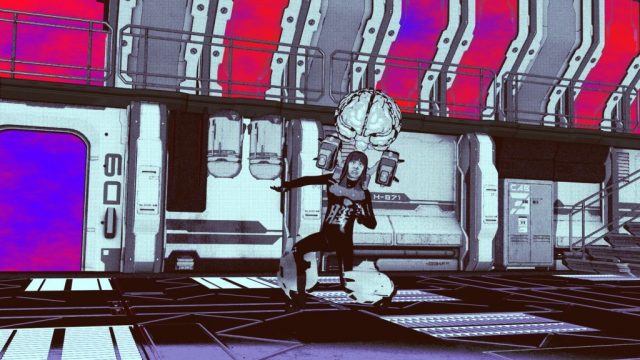
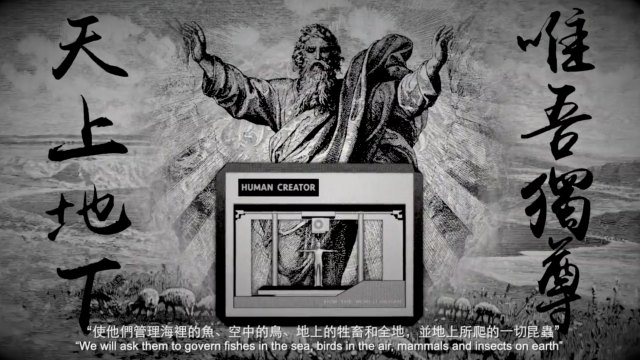

LuYang Delusional Crime and Punishment is a personal nightmare that revolves around desires, sins, and the brain. In this techno music/dance video, the artist Lu Yang takes her 3D-printed, de-gendered cyborg bodies through multiple hells. I find that the part of this work most relevant to our course is the capture of the artist’s body and the imposition of a rendered body onto a fantasy world. Her fabricated body serves as a vessel to question subjectivity and explore the questions of who created our bodies, why our bodies desire, why do these desires translate to sins in many religious systems across the world, and whether everything is just happening in the brain. Images of science and technologies are juxtaposed with imagery of the spiritual. Futuristic, fantastical machines are displayed next to devils, cadavers, and other delusional violence. At some point, the scenes of punishment happen in a surgery room, where the artist’ body violently tremble while its brain opens up, revealing its robotic nature.
I find the overwhelming amount of visceral imagery in this video effective in that it heightens the tension between the scientific and the spiritual, and highlights the artists’ struggle with subjectivity when thinking about the origin of desires and sins. I also like that this video has a great deal of entertainment value. With its dance numbers, upbeat techno music, and fantastical imagery, it provides the satisfying kind of sensory overload. The artist Lu Yang has never resisted the commercial aspect of her work. Her work has always drawn from popular culture and very much adds to it.
CHECK OUT FULL VIDEO: LuYang Delusional Crime and Punishment ( Music by GAMEFACE )
Christian Marclay’s The Clock is not only a feat in film editing, I feel it’s also in a way a snapshot of the sheer volume of film, and to a degree, human culture. A looping 24 hour film, The Clock is a series of film clips with clocks in them edited together that so that the time presented on the clocks in the film coincides with the real life time of day the film is being shown. Due to this, the viewer is in essence watching the time pass by as the film progresses, with the film itself functioning as a clock.
I find is particularly interesting both as a feat of editing but also as a form of abstraction of time. There’s a curious tension between being wholly aware of the time as a physical construct (ie the clock) while altogether being separated from the cultural notions of time (ie death, business etc) that arise through existing as a human being. I also marvel at the fact that humanity has produced enough film to present all 24 hours on clocks.
Dirk Koy is an incredible visual artist, and I could have mentioned a number of their pieces. One particularly relevant to the course would be Escape Route, a video in which the viewer flies through a 360 degree photogrammetric scan of portions of Basel. As one flies through, the city itself deforms through a series of effectors, such as vertex displacement and different visualizations of color to the data, such as mesh lines, photo color, or depth. As one moves, a catchy soundtrack meant to evoke a spy movie escape scene plays in the background.
This piece is impressive partially due to the sheer size of the capture, which I feel is worth mentioning. What becomes particularly relevant to the course is the choices that Dirk makes about visualization. There exists the objective Basel, the captured Basel, and the Basel that is visualized at a given moment, including the displaced geometric version.
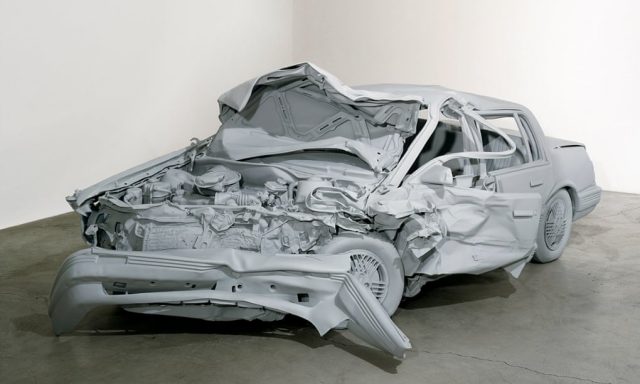
Unpainted Sculpture, by Charles Ray, is a recreation of a real car that was part of a fatal crash. Every visible part of the car, from the engine to the license plate to the leather seats, was cast and duplicated in fiberglass and then reassembled to create this sculpture (it was also, despite its name, painted gray). The result is a haunting shadow of the original car, frozen in time and missing any stains, dirt, or chipped paint we would expect on a crashed car. Though the car’s pieces are mangled, they are cleanly and evenly colored, putting all of the focus on the shape itself.
I think that 3D casts like this are an interesting form of capture. Though the premise here is very simple, the sculpture is very impactful, especially in person. It’s also not entirely objective. In addition to choosing what car to cast, Ray made some other artistic decisions, like not to cast any of the windows (I’m assuming they didn’t all break away completely, and that he instead omitted them so we could see inside), and what material to use. I think that the smooth gray color makes this look like a figurine that has yet to be painted, like it’s been mass produced exactly like this, which adds to its eerie energy.
Austine Comarow, is an artist that works with light and manipulates the polarity of light in order to create bright colourful images. By using specific plastics, she is able to create patterns by altering the wavelength of polarized light which can only be revealed when looked through another filter. By doing so she is able to “encode” images in light without the audience realizing it until looked at through a special filter thus revealing a new image. I find this to be particularly interesting because she is was able to take relatively basic physics problem make it magical and unreal through this revealing and changing of light.
Breaking Wave – Austine Studios
I was recently at the New Museum In New York City. I had been drawn there by the work of Hans Hacke, specifically his kinetic and environmental art. The museum had devoted one large space to the pieces in question — the room was filled with undulating fabric, a balloon suspended in an airstream, acrylic prisms filled with water to varying degrees with water, and more. Each of these pieces represented a unique physical system that was dependant on the properties of the physical space it was curated in or the viewers that interacted with it. One specific piece that caught my eye was a clear acrylic cylinder filled, almost completely, with water, and suspended from the ceiling. It was in essence a pendulum with water sloshing around inside. I found myself intrigued by the way the water moved and air bubbles oscillated as the larger system moved. There’s a highly complex relationship between the dynamics of the fluid and that of the pendulum. Connecting this back to experimental capture: how we can capture and highlight this kind of complex dynamic system? What if you had a robot driven camera followed the motion of the watery pendulum? What if you used a really big camera that highlighted the act of robot capturing the pendulum? If you curated the robot, the pendulum, and the captured video together how would that change the piece?
I get excited by art that can spur ideas and inspiration in me – that’s why I got excited about Hans Haacke’s kinetic art.
Link to New Museum Show: https://www.newmuseum.org/exhibitions/view/hans-haack
